Practicing gratitude encourages us to recognize and appreciate the good in our lives, thus fostering a sense of contentment and resilience.
Gratitude journaling, in particular, is a powerful tool for cultivating appreciation and offers numerous mental and physical health benefits.
This article explores the Stoic approach to gratitude and how journaling can help us embrace and embody these timeless teachings.
The Stoic Foundation of Gratitude
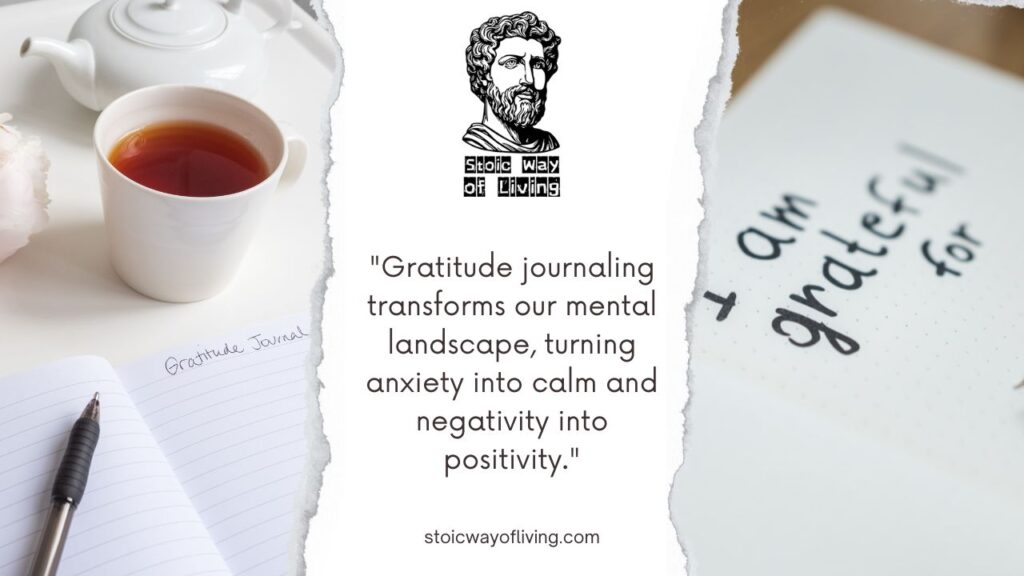
In Stoic philosophy, gratitude is vital for achieving tranquility and contentment. Stoicism teaches that happiness depends not on external circumstances but our internal state and perspective.
Gratitude plays a crucial role in this internal state by helping us focus on what we have rather than what we lack, thus fostering a sense of sufficiency and peace.
In his “Meditations,” Marcus Aurelius emphasized the importance of gratitude in acknowledging the positive aspects of life, even amidst adversity.
Seneca advised cherishing what one has and appreciating the present moment, arguing that true wealth lies in wanting little and being grateful.
Epictetus taught that recognizing the benefits and support we receive cultivates a sense of appreciation and humility, aligning with the Stoic principle of focusing on what is within our control and accepting what is not.
A central Stoic concept, Amor Fati, or love of fate, perfectly encapsulates this attitude. It encourages us to embrace life’s events, both good and bad, as necessary and beneficial.
By practicing gratitude, we learn to see every experience as a valuable part of our journey, which helps us develop resilience and a positive outlook on life.
The Benefits of Gratitude Journaling
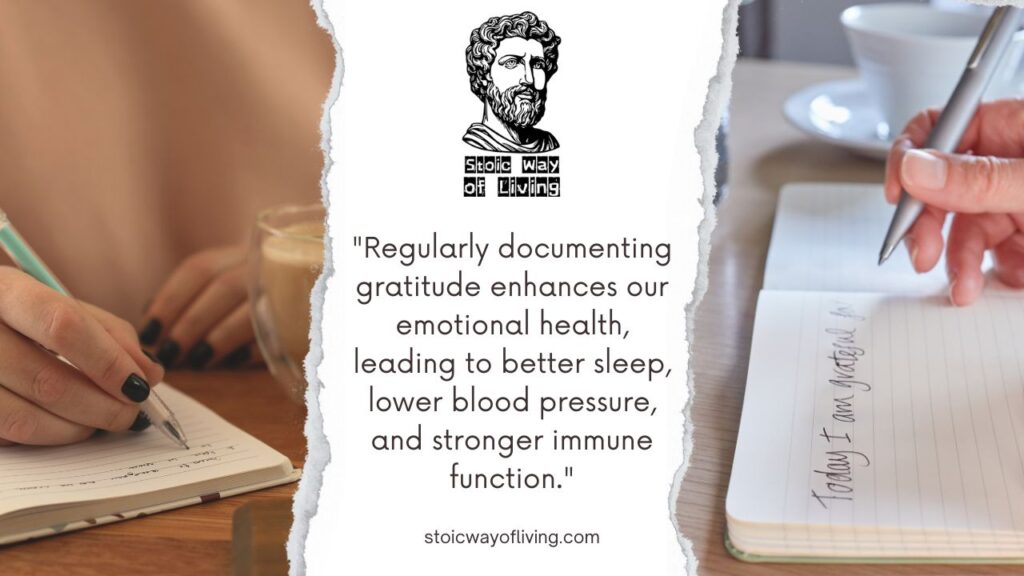
Gratitude journaling is a practice backed by a wealth of scientific research, demonstrating its profound impact on mental and physical well-being.
Regularly documenting what we are grateful for has been shown to reduce symptoms of depression and anxiety, fostering a more positive outlook on life.
This practice shifts our focus from negative to positive experiences, helping us cultivate a more optimistic mindset and enhance our overall emotional health.
Regarding physical health, gratitude journaling has been linked to improved sleep quality, lower blood pressure, and a more robust immune system.
Gratitude journaling also plays a crucial role in strengthening relationships. Regularly acknowledging and appreciating the people in our lives fosters deeper connections and a sense of empathy.
This practice encourages us to recognize the contributions and support of others, enhancing our interpersonal relationships and social harmony.
Practicing Gratitude Through Journaling
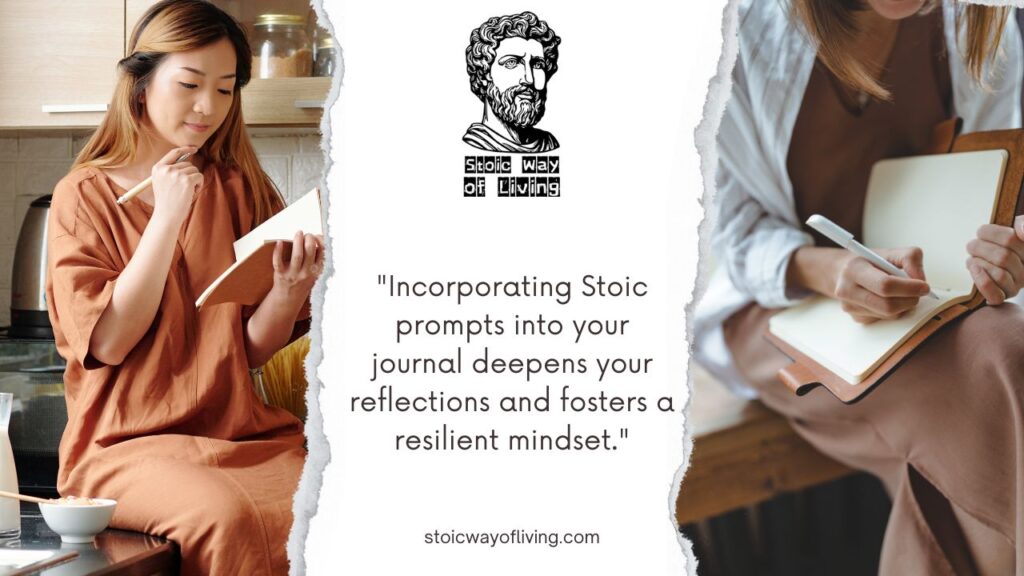
Beginning a gratitude journal is straightforward yet profoundly impactful.
Choose a format that suits your preferences—a traditional notebook, a digital app, or a simple document on your computer.
The key is consistency, so select a medium that you find convenient and enjoyable to use.
Set aside a specific time each day or week for journaling. Many find that writing in the morning or before bed helps frame the day positively or reflect on the day’s experiences.
Consistency in timing helps establish a routine, making it easier to maintain the practice over the long term.
Incorporate Stoic-inspired journaling prompts to deepen your reflections. Here are some prompts to get you started:
- Daily Reflections: Begin by noting what went well today. Reflect on the positive events, no matter how small, and how they contributed to your day.
- Negative Visualization: Consider what could have gone wrong but didn’t. Reflecting on potential adverse outcomes helps you appreciate the positive events and the things you often take for granted.
- Appreciation for People: Write about the people for whom you are grateful. Focus on their actions, words, and presence that positively impacted your life.
- Interconnectedness: Acknowledge the circumstances and external factors that contributed to your well-being. This could be as simple as good weather or the functioning of public services.
Reflecting on daily events with a focus on what went well and practicing negative visualization are core Stoic exercises that enhance your appreciation for life’s positives.
Integrating Stoic Practices into Your Gratitude Journal
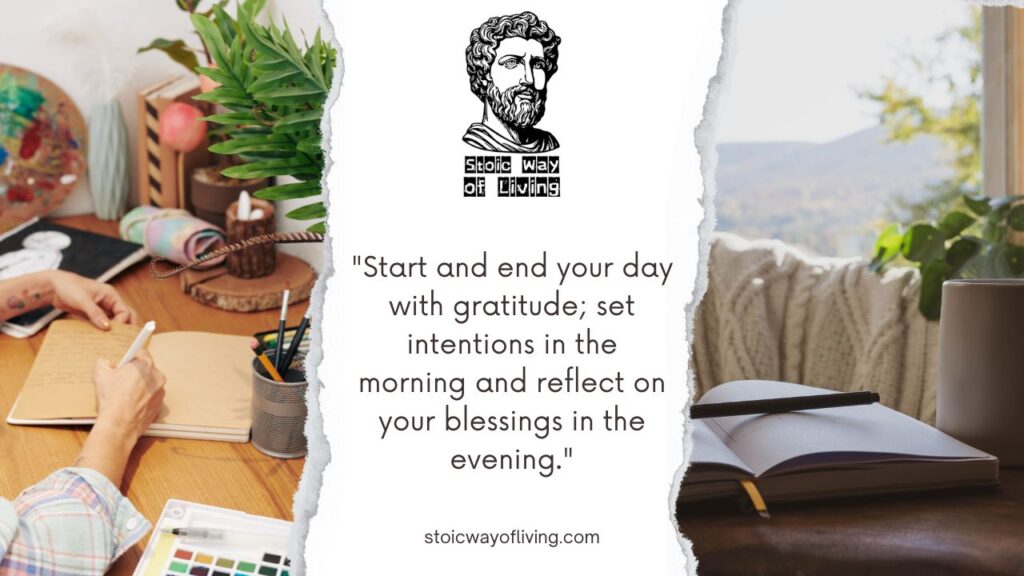
To maximize the benefits of your gratitude journal, integrating Stoic practices can provide a richer and more profound experience.
Combining gratitude journaling with Stoic exercises enhances your appreciation for life’s positives and deepens your philosophical and personal growth.
Morning and Evening Reflections
Start and end your day with purposeful reflection.
In the morning, set intentions by contemplating what you aim to achieve and how you plan to maintain a grateful and resilient mindset throughout the day.
In the evening, reflect on positive experiences, interactions, and accomplishments, and consider what you learned from challenging situations.
Dichotomy of Control

The dichotomy of control is a fundamental Stoic principle that differentiates between what is within our control and what is not.
When journaling, categorize your reflections accordingly.
For instance, express gratitude for the effort you put into a project (within your control) and acknowledge the favorable outcome (beyond your control).
Practicing Mindfulness and Presence
Practice mindfulness by noting small details that bring joy and satisfaction in your gratitude journal.
This could include the sun’s warmth, the taste of your morning coffee, or a brief moment of quiet.
Paying attention to these small but significant experiences creates a greater appreciation for everyday life.
Negative Visualization
Negative Visualization, or imagining the absence of the things you cherish, is a powerful Stoic exercise.
Use your journal to reflect on your life without certain people, possessions, or experiences.
This enhances your gratitude for what you have by highlighting its value and reminding you not to take it for granted.
Gratitude for Challenges
Stoics see challenges as chances for personal growth.
In your journal, be grateful for difficulties, recognizing how they develop resilience, wisdom, and strength.
Reflecting on how you handled obstacles and what you learned turns setbacks into valuable life lessons.
Example Entries
To illustrate, an example entry might look like this:
- Morning Reflection: “Today, I am grateful for the opportunity to improve my work skills. I will approach challenges positively and focus on what I can control.”
- Evening Reflection: “I am thankful for the support of my team during a difficult project. Although the outcome was uncertain, we worked together and achieved a great result. This experience taught me the value of collaboration and perseverance.”
- Negative Visualization: “Imagining my life without my health reminds me not to take it for granted. I appreciate the ability to exercise and enjoy physical activities.”
Overcoming Challenges in Gratitude Journaling
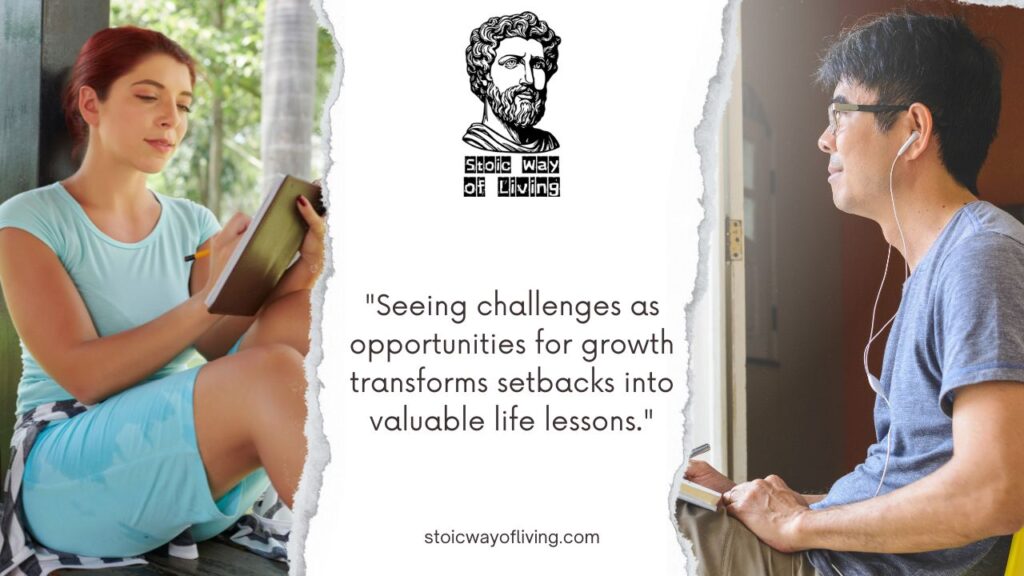
Maintaining a gratitude journal can present challenges like consistency, motivation, and negative emotions.
To overcome these, remember Stoic strategies for perseverance. Reframe challenges as opportunities for growth, a critical Stoic concept.
When motivation wanes, remind yourself of gratitude’s benefits and positive shift in perspective.
To address negative emotions, use journaling as a rational thinking and perspective tool.
Acknowledge difficulties, but balance them with gratitude for the good in your life. Avoid superficiality by diving deep into your reflections.
Detail why you are grateful, focusing on specific aspects and their impact on you.
See also: The Benefits of Daily Self-Reflection – All You Need to Know!
Conclusion
When combined with Stoic principles, gratitude journaling offers a powerful tool for enhancing well-being and fostering a resilient, contented mindset.
Regularly reflecting on the good in our lives aligns with Stoic teachings, focusing on what is within our control and embracing life’s events with acceptance and grace.
This practice enhances our mental and physical health, strengthens our relationships, and deepens our philosophical understanding.
For those looking to deepen their gratitude practice, consider exploring “52 Essential Gratitude Attitude.” This resource, designed by a Harvard educator, offers empowering prompts, self-help affirmations, and insightful quotes to guide you through a year of gratitude. Check it out on Amazon to begin enhancing your gratitude practice.


